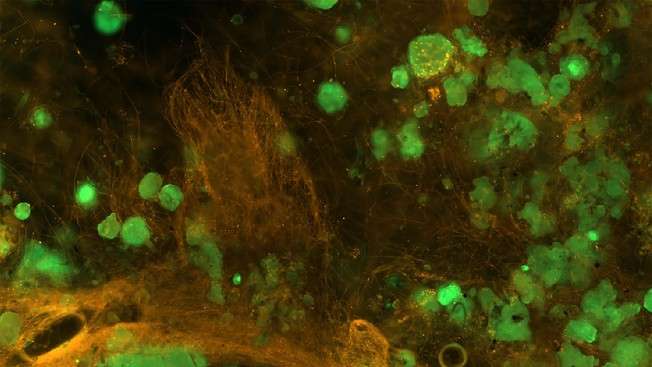Hydraulics is a key driver of microbial life in streams and rivers

In streams and rivers, bacteria, algae, and other microorganisms form tight-knit communities that feed the ecosystem, drive its biodiversity, and purify its water. These communities exist in several forms, swimming freely, clumping together, or as biofilms that attach to rocks and other surfaces. For the first time, a team of researchers has shown that the amount of turbulence the microorganisms are exposed to determines the form of their community. Their findings, published in the journal Nature Microbiology, have important implications for river health, biodiversity, and water quality.
"In streams, life-enabling energy comes in two currencies: dissolved organic carbon and sunlight. Both first have to be captured and transformed in order to become accessible to species that occupy the higher rungs of the food chain," says Tom Battin, the senior author of the study. In nature, communities of microbes carry out this critical job.
Flipping the switch
"After decades of thinking that these microbial communities existed predominantly as free-floating cells, we now understand that most microbial life in streams and rivers occurs as biofilms and aggregates," says Battin. While free-swimming communities are most common in open water, biofilms are found mainly in turbulent water. Aggregates tend to form anywhere in between.
Robert Niederdorfer, PhD in Battin lab and first-author of the study, set out to determine what drove the communities to take on a specific lifestyle. Did random chance dictate which bacterial species, and consequently, which lifestyle would prevail? Or could, as they hypothesized, hydraulics, as the level of turbulence, flip the switch from one lifestyle to another?
To find out, he extracted free-swimming bacterial communities from a headwater stream and from floodplains further downstream. Then, he cultured both samples in two experimental setups, one using large rotating tanks of water to mimic the low-turbulence conditions encountered in large rivers and their floodplains, the other mimicking turbulent alpine streams by continuously running water down inclined slopes.
Hydraulics trumps chance
Regardless of where the microorganisms had initially been extracted, those injected into rolling tanks formed aggregates, while the others formed biofilms. But remarkably, molecular analysis of the biofilms and aggregates showed that these differed strongly in species composition, even when they were grown using the same initial bacterial community. "The fact that community composition shifted independently of the source but according to their microbial lifestyle means that hydraulics is a more powerful driver than random processes," says Battin.
Using bioinformatics, Hannes Peter, co-author of the study, revealed that the differentiation process was driven by key microbial species that are particularly well adapted to the various turbulence environments. For example, in high turbulence settings in the presence of surfaces, good biofilm formers prevailed and went on to form the backbone of a community that other species of microorganisms latch on to.
The study's findings have immediate implications for promoting stream ecosystem health. "Increase the hydraulic variability along streams and rivers and you boost microbial life and diversity!" says Battin. Further down the line, it also suggests ways to engineer biofilms for industrial applications. "The fact that differentiation into distinct lifestyles is not stochastic but rather deterministic means that one day we may be able to use hydraulics to engineer biofilms and their communities to perform certain tasks in industrial systems. Of course, we still have a long ways to go," he concludes.
More information: Robert Niederdorfer et al. Attached biofilms and suspended aggregates are distinct microbial lifestyles emanating from differing hydraulics, Nature Microbiology (2016). DOI: 10.1038/nmicrobiol.2016.178
Journal information: Nature Microbiology
Provided by Ecole Polytechnique Federale de Lausanne


















